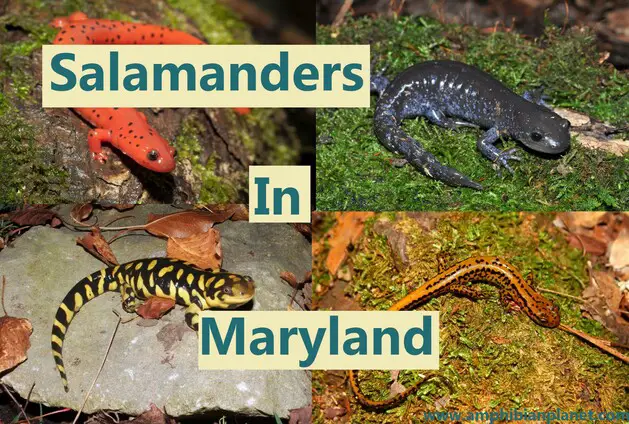The red-backed salamander is the most common salamander in the state of Maryland. It can be found from the coast of Worcester County all the way west to the mountains of Garrett County.
Though these tiny salamanders may look similar to Lizards, they are quite different. All salamanders are amphibians, just like frogs and toads.
They have smooth permeable skin that they keep constantly moist by secreting mucous. They use this skin to breathe and absorb water (amphibians do not drink through their mouths as we do).
To prevent their skin from drying out, salamanders usually hide under rocks, logs, and other debris in moist environments.
Since there are so many different salamander species, the exact size and coloration varies between species. Also, they can either be semi-aquatic, fully-aquatic, or fully terrestrial (depending on the species).
Native Salamanders of Maryland
Maryland is home to 22 salamander species, some species more common than others. If you ever spot a salamander in Maryland, It’s probably one of these. You can potentially see salamanders of any age or gender!
1. Spotted Salamander (Ambystoma Maculatum)


Spotted salamanders (sometimes called “yellow-spotted salamanders“) are fairly large, ranging from 6 to 7 inches long, with females typically larger than males.
They get their name from the two roles of yellow or orange spots speckled along their black backs and sides. Their underside is pale gray with no spots.
Spotted salamanders have broad heads and thick, heavy bodies with vertical grooves on each side of their body.
These salamanders are found in the eastern and south-eastern parts of the United States, and into eastern Canada. In Maryland, they are found throughout much of the entire state except on the lower Eastern Shore.
2. Eastern Tiger Salamander (Ambystoma Tigrinum)
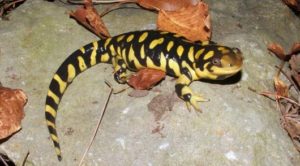
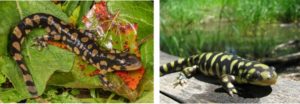
Tiger salamanders range from 6 to 8 inches, which makes them the largest terrestrial salamanders in Maryland, and one of the largest terrestrial salamanders in North America.
These salamanders can be easily identified by their dull brown coloration, with olive-yellow to brownish-yellow irregular markings (“tiger stripes”). The markings can be large spots, stripes, or irregularly shaped spots.
Tiger salamanders spend most of the year in underground burrows making them difficult to spot. You are most likely to see one of these salamanders during the breeding season when they come above ground and migrate to breeding ponds.
Eastern tiger salamanders live throughout most of the United States, southern Canada, and eastern Mexico. This makes them one of the most widely distributed salamanders in North America. They are currently endangered in Maryland.
3. Marbled Salamander (Ambystoma Opacum)


Unlike the tiger the spotted salamander, marbled salamanders are fairly small, only growing 3 to 5 inches in length.
These salamanders are dark grey to black with silvery crossbands running along with their chunky bodies. Because of this appearance, they are sometimes called “banded salamanders“.
Male marbled salamanders are typically smaller than females and have whitish crossbands that become very white in the breeding season.
Marbled Salamanders have been seen in nearly every county in Maryland, with the exception of Carroll and Garrett Counties.
4. Jefferson Salamander (Ambystoma Jeffersonianum)
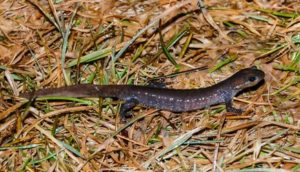

Jefferson salamanders can be easily identified by their grey or dark brown-colored back with blueish-white speckling on the lower sides. The speckling is most visible in younger salamanders and may disappear in older adults.
These salamanders are mediumly sized, ranging from 4 to 7 inches in length with females being larger than males.
Jefferson salamanders have a really long tail, (almost as long as the body) which is vertically compressed but nearly rounded at the base.
Jefferson Salamanders are found from eastern Illinois and south-central Kentucky northeast to northern Virginia and southwestern New England.
In Maryland, they range from the eastern edge of the Allegheny Plateau to the western edge of the Piedmont.
5. Red Salamander (Psuedotriton Ruber)


Red salamanders are 6 to 7 inches in length and have a bright orangish-red coloration with random black spots on the back and sides. Older red salamanders are typically darker and may have fused spots making them look purplish brown.
These salamanders have a short tail and have 16 grooves along their body. Like many salamanders, females are larger than males.
Red salamanders are found in the eastern United States, from Alabama to northern New York. In Maryland, they have been recorded throughout much of the state.
6. Mud Salamander (Psuedotriton Montanus)


Mud salamanders grow between 3 and 6 inches in length. They have a reddish-brown coloration with well-black spots which makes them look very similar to red salamanders.
However, there are several ways you can tell these two salamanders apart.
- The red salamander has spots that are irregularly shaped and frequently overlap. In contrast, the mud salamander has fewer spots that are well separated from one another and do not overlap.
- The red salamander has a golden/Yellow iris. In contrast, the Iris of the mud salamander is solid black/brown color
- The red salamander has long snout. In contrast, the snout of the mud salamander is shorter and more blunt
Mud salamanders are found from southeastern Louisiana east to the Atlantic Coast, north to southern New Jersey, and westward to the Illinois boundary. In Maryland, they range through the coastal plain to the western and eastern shores.
7. Northern Dusky Salamander (Desmognathus Fuscus)


Northern dusky salamanders are on the smaller side, only growing between 2 and 4 inches in length.
Their coloration is highly variable, but they are generally tan to dark brown in color with sparse dark spots that are concentrated on the sides, and may also have a light dorsal stripe or two dark dorsal stripes.
Younger individuals may have paired round yellowish spots bordered by a dark wavy band. In older individuals, the spots are gone and the wavy band may be indistinguishable from the body color.
As in all dusky salamander species, a pale line runs diagonally from the eye to the jaw, and the hind legs are larger than the front legs.
Northern Duskies are found throughout Maryland except for the southern Eastern Shore counties.
8. Allegheny Mountain Dusky Salamander
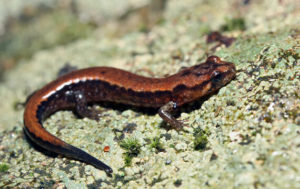
This is a subspecies of dusky salamander, so it is very closely related to the Northern Dusky.
Allegheny Mountain Dusky Salamanders are extremely similar to their relatives. They are the same size and share the same features. Their main physical difference is their coloration.
- The Allegheny Mountain Dusky is typically more brightly colored with a dorsal stripe that is yellow to red with chevron-shaped dark patches alongside the stripe and a dark underside.
- The Northern Dusky, on the other hand, has a tan or brown stripe with no markings and a pale cream-colored underside.
The Allegheny Mountain Duskies are common in western Maryland, distributed in Garrett and Allegheny Counties.
9. Green Salamander (Aneides Aeneus)
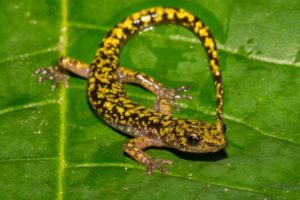
Green salamanders are quite easy to identify because they are the only salamander in Maryland with green-colored blotches on the back. They grow 3 to 5 inches in length.
The body and head are flattened with numerous green to yellowish-green markings that resemble lichens. No other salamander in Maryland has green markings. So, If you ever see a salamander with green markings in Maryland, it is 100% a green salamander.
This salamander is found near the northern edge of Garrett County, and it is considered state-endangered.
10. Seal Salamander (Desmognathus Monticola)

The seal salamander is one of a group of species called “stream salamanders”. They get their name from the “seal like” posture they hold when alert.
These salamanders grow between 3 and 5 inches in length, with the tail comprising about half the total length of the body.
Seal salamanders have an extremely variable coloration. However, they generally have a molted back, usually dark brown to black on a grey or light brown background.
The belly is light grey to white, with grey or light brown markings. Some individuals may also have a single row of white dots on the sides and legs.
Seal salamanders are very secretive and rarely stray from the water, so they are not frequently encountered.
In Maryland, they are only found in the Garrett and Allegheny Counties where they inhabit the banks of cool streams.
11. Spring Salamander (Gyrinophilus Porphyriticus)
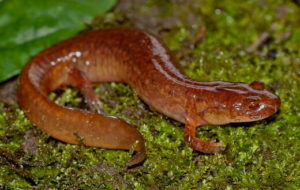

Spring salamanders are about 4 to 8 inches in length and have an orangish-pink body; covered in faint small black spots or flecks. Sometimes, their coloration can be yellowish-brown with a mottled appearance.
These salamanders have slender bodies, a light line extending from the eyes to the nostril, and a ridge along their tail to help them swim better.
Spring salamanders around the Appalachian Mountains and north into the Adirondacks and just into Canada. In Maryland, their range is restricted to the Piedmont west into the mountains.
12. Northern Slimy Salamander (Plethodon Glutinosus)
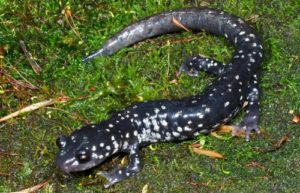
Northern slimy salamanders are mediumly sized, growing between 4 and 6 inches in length.
They are easy to identify by their bluish-black bodies with numerous, well-scattered white spots on the back and sides. The spots along the sides of their bodies may fuse and form a broad band.
Slimy salamanders get their name from the very sticky mildly toxic goo they secrete when threatened. This goo sticks to the predator’s mouth enabling the salamander to escape.
In Maryland, northern slimy salamanders range from the Piedmont into Garrett county and are generally much more common in the western counties
13. Northern Two-Lined Salamander (Eurycea Bislineata)


Northern two-lined salamanders are on the small side, only growing between 2 to 3 inches in length. You easily identify them by their greenish-yellow or orange back with two parallel dark brown or black lines running from their eyes to their tail.
Male two-lined salamanders have small projections from the nostrils that point downwards. These projections are thought to help them in chemoreception.
Northern two-lined salamanders are common throughout out much of the state of Maryland.
14. Southern Two-Lined Salamander (Eurycea Cirrigera)
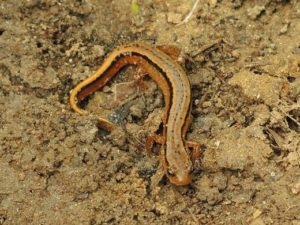
As their name suggests, southern two-lined salamanders are extremely closely related to Northern two-lined salamanders. In fact, these two salamanders are nearly identical.
Their main distinction is that; while the northern two-lined salamander has 15-16 costal grooves between its limbs, the southern two-lined salamander only has 14 costal grooves.
Besides this tiny difference, they can be difficult to tell apart.
Southern two-lined salamanders were only recently discovered in Maryland (2007) so not much is known about their range. However, it is assumed they share the same range with the northern two-lined salamander.
15. Eastern Red-Backed Salamander (Plethodon Cinereus)
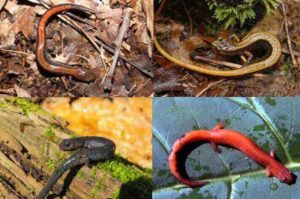
Red-backed salamanders have slender bodies and reach between 2 and 5 inches. Despite their name, not all “red-backed ” salamanders have the color red on their backs.
They have many color variations but mainly have two variations: The red-back, and the lead- morph.
The red-back morph has a straight-edged reddish stripe (sometimes orange, yellow, or dark grey) running the length of its back from the base of the head to the tail, with dark sides. The lead-back morph, on the other hand, lacks the red stripe. It has a purely dark grey to black color on its back instead.
Red-backed salamanders are Maryland’s most common salamander species, distributed across most of the state.
16. Four-Toed Salamander (Hemidactylium Scutatum)
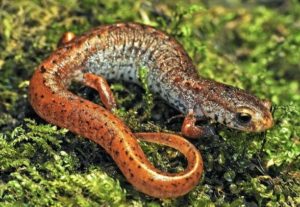
Four-toed salamanders range from 2 to 4 inches in length. They get their name from the four toes on both their front and hind feet. No other salamander species has 4 toes on each foot (most salamanders have five toes on the back feet).
Four-toed salamanders have a reddish-brown or grey-brown coloration on the back, with grey sides and a white belly with black spots.
These salamanders also have an obvious constriction at the base of the tail where it can detach if grabbed by a predator, allowing the salamander to escape.
Four-toed salamanders can be found from Maine to Minnesota and as far as Alabama in the south. In Maryland, they are most common in the Piedmont and lower elevations of the mountains.
17.Wehrle’s Salamander (Plethodon Wehrlei)
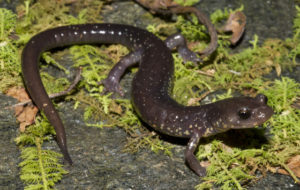
Wehrle’s Salamanders are moderately sized growing between 4 and 5 inches in length. They have a dark brown to black coloration with white, bluish-white, or yellowish spots or blotches along the sides of the body. These spots are sometimes organized in two rows.
These Salamanders have a uniformly grey underside except for the throat and upper chest which are blotched with white or yellow.
In Maryland, Wehrle’s salamanders are found only in Garrett and in western Allegheny Counties.
18. Valley and Ridge Salamander (Plethodon Hoffmani)
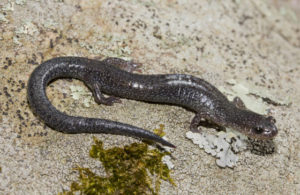
These salamanders are 3 to 5 inches in length, with smallish legs and a long tail. Since they are really slender, they appear elongated, kind of like a worm with legs.
Valley and Ridge Salamanders have dark brown to black coloration with small gold or silver flecks. The throat is whitish and the belly shows light mottling.
These salamanders are found in the ridge and valley and mountains of western Maryland, from Washington County to Garrett County.
19. Long-Tailed Salamander (Eurycea Longicauda)

Long-tailed salamanders are often yellow but can range in color to red, orange, and brown and have irregular dots and dashes along their slender bodies and tails.
As their name suggests, they have really long tails. They grow 4 to 8 inches, with 60% of this length being their tails.
Long-tailed salamanders in Maryland range through the Piedmont into the mountains of western Maryland.
20. Eastern Red-Spotted Newt (Notophthalmus Viridescens)

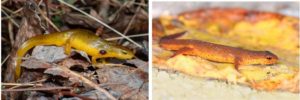
Eastern red-spotted newts grow between 2 and 5 inches in length and are the only newt species found in Maryland. Unlike most salamanders, many newts (including the eastern red-spotted newt) have rough skin that is slightly moist, (just enough to keep it from drying out).
In the Juvenile eft stage (which lasts about 3 to 4 years), eastern red-spotted newts have a bright orange-red coloration with a rounded tail.
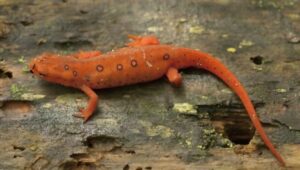
As adults, they generally have a yellowish-brown to greenish-brown coloration, with black-bordered red spots along their back; and a less rounded tail. The underside is yellow with small dark spots.
Males develop enlarged hind legs and a high wavey crest on their tails during the breeding season.
Eastern red-spotted newts are common throughout most of Maryland but are rare on the eastern shore.
21. Mudpuppy (Necturus Maculosus)


Mudpuppies reach 7 to 16 inches and are one of the few salamanders that are vocal. They get their name from their squeaky scream which sounds somewhat like a dog’s bark.
They are fully aquatic for their whole lives and retain their larval features even as adults. They have large feathery gills, four feet, and a flat fin that runs down the length of their body.
Their coloration is usually brownish-black with bluish-black spots or blotches. However, younger mudpuppies are often black with yellow stripes running along the length of their bodies.
In Maryland, mudpuppies are listed as endangered/extirpated, meaning that they once lived in the state but are not known to now. They were last observed in Garrett County in the 1970s.
22. Hellbender (Cryptobranchus Alleganiensis)


Like the mudpuppy, hellbenders are fully aquatic. However, unlike the mudpuppies, hellbenders do not have gills. Rather, they breathe underwater through their skin.
Their skin has lots of folds and wrinkles which provides a large surface area to absorb oxygen in the water. Hellbenders can grow up to 29 inches in length, making them the largest salamanders in North America.
They can be easily identified by their wide flat heads, paddle-shaped tail, and their brown coloration with irregularly shaped dark spots along their back.
Like the mudpuppy, hellbenders are listed as endangered in Maryland. They are currently known only from a couple of rivers in Garrett County.
Final Thoughts
Maryland has 22 salamander species, with some species being more common than others.
There are salamanders small enough to fit in the palm of your hand, but they’re also large salamanders such as the hellbender.
These fascinating amphibians are all over Maryland, and you’re sure to catch sight of one eventually if you take the time to look!

